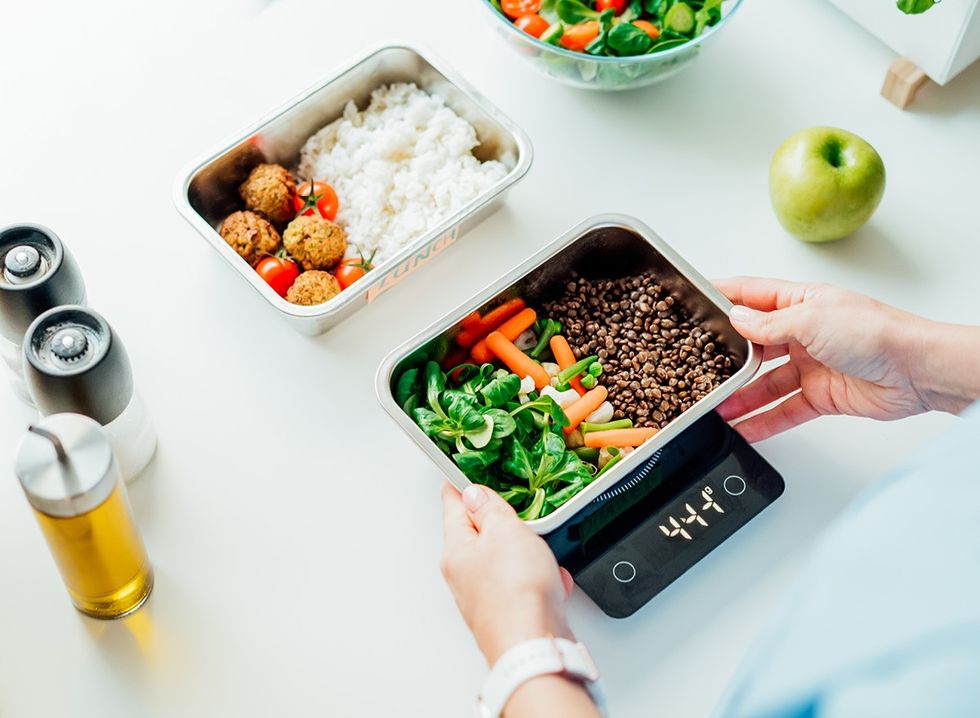Looking at the scale not budging despite your best efforts? You're not alone. Many of us struggle with weight loss, often feeling frustrated when results don't match our expectations. That's where Layna from Frumpyfit comes in. As a certified weight loss coach and fitness trainer with a thriving YouTube community, Layna has helped thousands of women achieve sustainable weight loss through practical, no-nonsense advice. Here are her insights on the mistakes that might be holding you back – and, more importantly, how to fix them.
Stop Copying Other People's Weight Loss Journey
"About 90% of people make the mistake of simply following what worked for someone else," says Layna in her post. While it's tempting to copy someone who's achieved the results you want, their path may not fit your lifestyle or needs. The fundamental principle is creating a calorie deficit, but how you get there should be tailored to your specific situation.
"We know that a calorie deficit is required for weight loss, but there are a million different ways that you can accomplish a calorie deficit," Layna emphasizes. This means you need to find your own path that aligns with your schedule, preferences, and lifestyle constraints.
The Science Behind Sustainable Weight Loss
The science supports Layna's focus on sustainable approaches. According to the National Weight Control Registry, "about 20% of people who lose at least 10% of their body weight maintain it for at least a year." The key? Consistent habits, not quick fixes.
Don't Rush Your Weight Loss Goals
Setting unrealistic timelines can sabotage your progress. "When you expect quick results and don't see them, disappointment sets in," Layna explains. This frustration often leads to excessive restriction and yo-yo dieting.
"Disappointment ultimately sets you up for failure," she warns. "If nothing that I'm doing is working, why am I even trying? So we want to avoid that if we can." Instead, she recommends celebrating small victories and maintaining patience.
Realistic Weight Loss Goals Matter
The Mayo Clinic says that "a safe and sustainable rate of weight loss is 1 to 2 pounds per week." This aligns perfectly with Layna's emphasis on patience and celebrating small victories. The research shows that setting realistic expectations leads to better long-term success.
RELATED: This 58-Year-Old Trainer Lost Weight and Looks 15 Years Younger With 9 Daily Habits
Avoid the "Perfect Plan" Trap
Many people get caught up in finding the "best" workout program or diet plan. However, Layna points out that the most effective approach is the one you can maintain consistently. "It doesn't matter what's best on paper if you can't stick to it long enough to see results," she says.
"People with this all-or-nothing approach always tend to lean towards 'I have to be doing the best or I shouldn't be doing it at all,'" Layna observes. Instead, she advises, "Think it's only the best if I can do it, if I can stick to it, and I can get results from it."
Balance Your Progress Tracking
There's a delicate balance in tracking your progress. "When you don't have a solid plan or strategy for tracking your progress, then you are going to miss it," Layna notes. This is especially true with sustainable weight loss, where changes happen gradually.
On the flip side, obsessive tracking can be equally problematic. "Chances are you are getting results. It's just not showing up in the exact way that you are tracking it," she explains. The key is finding a middle ground.
RELATED: This Fitness Coach Transformed Her Body With 21 Simple Changes
Choose the Right Metrics
"A lot of people think of weight loss progress tracking as just being the scale," Layna points out. However, she emphasizes the importance of a more comprehensive approach. "There are so many other different ways... You need an extremely holistic, balanced, and chill way to track your progress."
If certain tracking methods trigger negative emotions, adjust your approach. "If the scale makes you obsessive, no matter what, do not use the scale," she advises.
Focus on Your Minimum Effective Dose
The fitness industry often overcomplicates weight loss. "Many people focus on minor details that barely move the needle," Layna observes. She advocates for identifying what gives you the "most bang for your buck" and ignoring everything else.
The Role of Protein in Weight Management
Another finding from the Mayo Clinic shows that "protein decreases the hunger hormone ghrelin and increases hormones that promote feelings of fullness." This scientific backing explains why Layna's approach to sustainable eating patterns works so effectively for long-term weight loss.
RELATED: 10 Secrets From a Woman Who Lost 60 Pounds Without Dieting
Build a Sustainable Plan
"Stop worrying about all these little tiny details and just stick to a consistent, easy, simple, basic plan," Layna recommends. This means applying fundamental principles in a way that works for your life rather than following someone else's complicated regimen.
Meal Prep: Science-Backed Strategy
Harvard Health adds that "preparing meals in advance allows for better portion control," supporting Layna's advice about keeping things simple and consistent. This research validates the importance of preparation in maintaining healthy eating habits.
Celebrate Small Wins
"Any amount of progress, literally the tiniest amount of progress, is still progress, and that deserves to be celebrated," Layna emphasizes. This mindset shift from expecting dramatic changes to appreciating incremental progress can make the difference between giving up and achieving lasting results.
RELATED: 8 Tips to Make Losing Weight Feel Effortless, From Proven Experts
Make Informed Decisions
Your tracking strategy should "give you enough information to help you make informed decisions about whether or not your weight loss plan is working, but not so much that it's going to make you obsessive over it," Layna advises. This balanced approach helps you stay on track while maintaining your mental well-being.
Your Path to Success
Remember, sustainable weight loss isn't about following a perfect plan – it's about finding an approach that works for your lifestyle and sticking to it consistently. As Layna emphasizes throughout her coaching, the key is to keep things simple, sustainable, and focused on what actually works for you. Start by implementing one or two of these fixes, and gradually build your way to a more effective weight loss strategy that fits your life. And if you enjoyed this article, take advantage of these 15 Quick Ways to Lose Body Fat Percentage in a Week.















 Shutterstock
Shutterstock Shutterstock
Shutterstock Shutterstock
Shutterstock Shutterstock
Shutterstock Shutterstock
Shutterstock Shutterstock
Shutterstock Shutterstock
Shutterstock Shutterstock
Shutterstock Shutterstock
Shutterstock Shutterstock
Shutterstock Shutterstock
Shutterstock Shutterstock
Shutterstock Shutterstock
Shutterstock

 Shutterstock
Shutterstock Shutterstock
Shutterstock Shutterstock
Shutterstock Shutterstock
Shutterstock Shutterstock
Shutterstock Shutterstock
Shutterstock Shutterstock
Shutterstock Shutterstock
Shutterstock Shutterstock
Shutterstock Shutterstock
Shutterstock Shutterstock
Shutterstock

 I'm a Nutritionist and These 9 High-Protein Snacks Keep My Clients Full While Losing 50 Pounds
I'm a Nutritionist and These 9 High-Protein Snacks Keep My Clients Full While Losing 50 Pounds
 Shutterstock
Shutterstock 2. Processed FoodsShutterstock
2. Processed FoodsShutterstock Shutterstock
Shutterstock Shutterstock/Prostock-studio
Shutterstock/Prostock-studio Shutterstock
Shutterstock Pro TipsShutterstock
Pro TipsShutterstock Shutterstock
Shutterstock Shutterstock
Shutterstock Shutterstock
Shutterstock Shutterstock
Shutterstock Don’t Drink as Much AlcoholShutterstock
Don’t Drink as Much AlcoholShutterstock Most Women on GLP-1s Are Making a Few Common MistakesShutterstock
Most Women on GLP-1s Are Making a Few Common MistakesShutterstock Soda and Sugary DrinksShutterstock
Soda and Sugary DrinksShutterstock Shutterstock
Shutterstock Eat BreakfastShutterstock
Eat BreakfastShutterstock And Improve Insulin SensitivityShutterstock
And Improve Insulin SensitivityShutterstock Belly Flab Strip Tip: Sugar and Fat Calories Leave Its Mark on Your BodyShutterstock
Belly Flab Strip Tip: Sugar and Fat Calories Leave Its Mark on Your BodyShutterstock Shutterstock
Shutterstock The Drugs Mimic the GLP-1 Hormone Naturally Produced by the BodyShutterstock
The Drugs Mimic the GLP-1 Hormone Naturally Produced by the BodyShutterstock 3. Deep-Fried ItemsShutterstock
3. Deep-Fried ItemsShutterstock